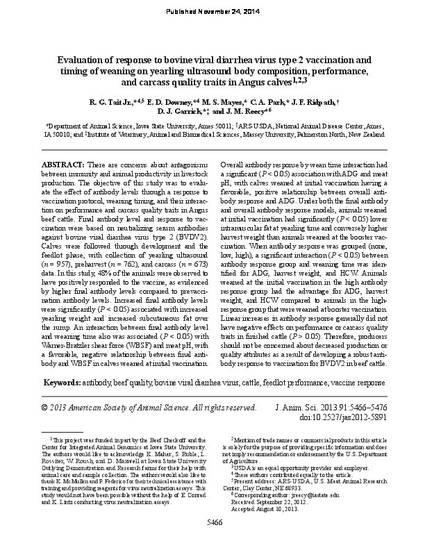
There are concerns about antagonisms between immunity and animal productivity in livestock production. The objective of this study was to evaluate the effect of antibody levels through a response to vaccination protocol, weaning timing, and their interaction on performance and carcass quality traits in Angus beef cattle. Final antibody level and response to vaccination were based on neutralizing serum antibodies against bovine viral diarrhea virus type 2 (BVDV2). Calves were followed through development and the feedlot phase, with collection of yearling ultrasound (n = 957), preharvest (n = 762), and carcass (n= 673) data. In this study, 48% of the animals were observed to have positively responded to the vaccine, as evidenced by higher final antibody levels compared to prevaccination antibody levels. Increased final antibody levels were significantly (P < 0.05) associated with increased yearling weight and increased subcutaneous fat over the rump. An interaction between final antibody level and weaning time also was associated (P < 0.05) with Warner-Bratzler shear force (WBSF) and meat pH, with a favorable, negative relationship between final antibody and WBSF in calves weaned at initial vaccination. Overall antibody response by wean time interaction had a significant (P < 0.05) association with ADG and meat pH, with calves weaned at initial vaccination having a favorable, positive relationship between overall antibody response and ADG. Under both the final antibody and overall antibody response models, animals weaned at initial vaccination had significantly (P < 0.05) lower intramuscular fat at yearling time and conversely higher harvest weight than animals weaned at the booster vaccination. When antibody response was grouped (none, low, high), a significant interaction (P < 0.05) between antibody response group and weaning time was identified for ADG, harvest weight, and HCW. Animals weaned at the initial vaccination in the high antibody response group had the advantage for ADG, harvest weight, and HCW compared to animals in the high-response group that were weaned at booster vaccination. Linear increases in antibody response generally did not have negative effects on performance or carcass quality traits in finished cattle (P > 0.05). Therefore, producers should not be concerned about decreased production or quality attributes as a result of developing a robust antibody response to vaccination for BVDV2 in beef cattle.
Available at: http://works.bepress.com/james_reecy/79/

This article is from Journal of Animal Science 91 (2013): 5466, doi:10.2527/jas.2012-5891.